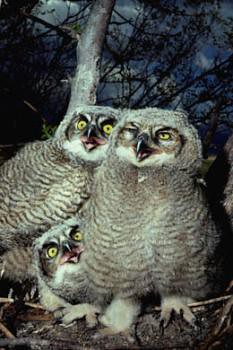Observations From The Nest of a Great Horned Owl
©Bert Gildart: Great horned owls begin nesting in February, and following an incubation period of 35 days and another 45 to 55 days of time for hatchlings in the nest, owlets are ready to fledge. If nesting took place in mid February, that means these three young owls (this is not an adult pair with its young) are about ready to fly the coop. Give them just a few more days and they’ll be gone.

Great-horned owl young
I took this photograph near Nine Pipes Refuge, which is adjacent to Montana’s National Bison Range. Though I recorded these owlets years ago, I know I made the picture in late April. However, May is an acceptable time to post this image for these young could linger in their nest through mid May. It all depends, of course, on when in mid winter the owl couple built their nest and laid their eggs.
Though I have photographed owls at many other settings over the years, the image of these three owlets is particularly instructive. Because they are so large and so well feed, the surrounding area had to contain a great deal of food; else the two strongest owlets might have pushed the weakest owlet one from the nest. Obviously that didn’t happen here so food was abundant.
Owls have gotten a bad rap, one they really don’t deserve. Essentially, some people dislike them because laws have prevented them from logging the last remaining old-growth forests in the West. Not much is left, and where these beautiful stands remain small populations of Spotted Owls eke out a living. Hard feelings, however, generally occurred long ago, and most developers have established a truce with spotted owls, though not all—and sadly these feelings carry over to all species of owls.
Instead of disliking owls, owls should really be admired for their traits. They work hard to feed their young. During my photographic vigil at this nest the adults consistently returned with mice and voles and, once, with a red-winged black bird.
What’s more, adult owls are highly protective parents, and when I approached this nest to set up a strobe I was bombarded by both parents even though I remained at some distance, relying for the image on a long telephoto lens. I set the strobe so that it would overpower the existing daylight, imparting a somewhat nocturnal cast.
Though not all owls are long lived, Great Horned owls may live 18 years, surpassed only by the long-eared owl, which may live 28 years. In captivity, the Great Horned may live 38 years but is then surpassed by the Great Grey owl, which lives 40 years under similar conditions.
Great horned owls are one of 14 different owls found in Montana. They are not, of course, confined to the Big Sky and range throughout the United States and Alaska and most of Canada as well. We’ve heard their familiar hoots often as we camped in our RV throughout the country and frequently in the evening at home—and always they add a bright note to our lives.

